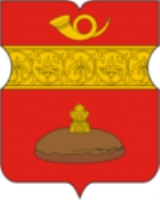
Basmanny District
Encyclopedia
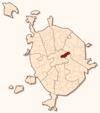

Moscow
Moscow is the capital, the most populous city, and the most populous federal subject of Russia. The city is a major political, economic, cultural, scientific, religious, financial, educational, and transportation centre of Russia and the continent...
, Russia
Russia
Russia or , officially known as both Russia and the Russian Federation , is a country in northern Eurasia. It is a federal semi-presidential republic, comprising 83 federal subjects...
. Population:
The district extends northeast from Kitai-gorod
Kitai-gorod
Kitay-gorod , earlier also known as Great Posad , is a business district within Moscow, Russia, encircled by mostly-reconstructed medieval walls. It is separated from the Moscow Kremlin by Red Square. It does not constitute a district , as there are no resident voters, thus, municipal elections...
, within the radial boundaries of Vorontsovo Pole Street and Yauza River
Yauza River
This article is about a river in Moscow, a tributary of the Moskva River. There are three other Yauza rivers in Central Russia: tributaries of the Lama, Gzhat and Sestra....
in the south and Myasnitskaya Street and Novaya Basmannaya Street in the north. It also includes the territory of Lefortovo Hospital on the opposite, southern bank of Yauza (between the river and Gospitalny Val Street). Historical Lefortovskaya Square also lies within Basmanny District, on the northern side of Yauza.
The district contains Kursky Rail Terminal
Kursky Rail Terminal
Kursky Rail Terminal is one of the nine rail terminals in Moscow. It was built in 1896.There are currently plans in the pipeline to completely rebuild or refurbish the Kursky Rail Terminal.-Long distance from Moscow:-Long distance via Moscow:...
, historical areas of Khitrovka
Khitrovka
Khitrov marketplace , also known as Khitrovka , was a square in the centre of Moscow from 1820 to 1930. This square was located in place of today’s house №11a in Podkolokolny sidestreet. In the second half of the 19th century Khitrovka became a bawdy place of Moscow, a den for thousands of...
, Clean Ponds, Red Gates (shared with Krasnoselsky District
Krasnoselsky District, Moscow
Krasnoselsky District Most of the district's territory is occupied by railroads, rail yards, and the three rail terminals around Komsomolskaya Square. It also contains a narrow sector of central Moscow, extending north-east from Lubyanka Square within the boundaries of Myasnitskaya Square and...
), German Quarter
German Quarter
German Quarter, also known as the Kukuy Quarter was a neighborhood in the northeast of Moscow, located on the right bank of the Yauza River east of Kukuy Creek , within present-day Basmanny District of Moscow....
and Basmannaya Sloboda
Sloboda
Sloboda was a kind of settlement in the history of Russia, Belarus and Ukraine. The name is derived from the early Slavic word for "freedom" and may be vaguely translated as "free settlement"....
. It retains memorial buildings of Petrine Baroque
Petrine Baroque
Petrine Baroque is a name applied by art historians to a style of Baroque architecture and decoration favoured by Peter the Great and employed to design buildings in the newly-founded Russian capital, Saint Petersburg, under this monarch and his immediate successors.Unlike contemporaneous Naryshkin...
, Neoclassicism
Neoclassicism
Neoclassicism is the name given to Western movements in the decorative and visual arts, literature, theatre, music, and architecture that draw inspiration from the "classical" art and culture of Ancient Greece or Ancient Rome...
and Art Nouveau
Art Nouveau
Art Nouveau is an international philosophy and style of art, architecture and applied art—especially the decorative arts—that were most popular during 1890–1910. The name "Art Nouveau" is French for "new art"...
periods. Its history is closely associated with Peter I of Russia
Peter I of Russia
Peter the Great, Peter I or Pyotr Alexeyevich Romanov Dates indicated by the letters "O.S." are Old Style. All other dates in this article are New Style. ruled the Tsardom of Russia and later the Russian Empire from until his death, jointly ruling before 1696 with his half-brother, Ivan V...
, Matvey Kazakov
Matvey Kazakov
Matvey Fyodorovich Kazakov was a Russian Neoclassical architect. Kazakov was one of the most influential Muscovite architects during the reign of Catherine II, completing numerous private residences, two royal palaces, two hospitals, Moscow University, and the Kremlin Senate...
and Alexander Pushkin. The district is home to Russia's largest engineering college, Moscow State Technical University.
Kitai-gorod to Garden RingGarden RingThe Garden Ring, also known as the "B" Ring , is a circular avenue around the central Moscow, its course corresponding to what used to be the city ramparts surrounding Zemlyanoy Gorod in the 17th century....
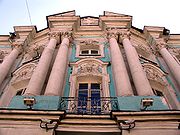
Izmaylovo District
Izmaylovo District is a district in Eastern Administrative Okrug of Moscow, Russia. It is a historical part of Moscow, the ancestral land of the Romanov noble family. Population: Area: .-History:...
and hosted court gardens and nobility; by 1638, 62 of 83 households belonged to upper classes (Sytin, p.103). At the same time, it was popular among foreigners; however, in 1643 the Church persuaded Tsar Alexey
Alexis I of Russia
Aleksey Mikhailovich Romanov was the Tsar of Russia during some of the most eventful decades of the mid-17th century...
to limit foreign presence and by 1652 all Catholic
Catholic
The word catholic comes from the Greek phrase , meaning "on the whole," "according to the whole" or "in general", and is a combination of the Greek words meaning "about" and meaning "whole"...
s and Lutherans had to relocate to German Quarter
German Quarter
German Quarter, also known as the Kukuy Quarter was a neighborhood in the northeast of Moscow, located on the right bank of the Yauza River east of Kukuy Creek , within present-day Basmanny District of Moscow....
, 2-3 kilomers north-west on the same route.
Most of the area burnt down in the Fire of 1812
Fire of Moscow (1812)
The 1812 Fire of Moscow broke out on September 14, 1812 in Moscow on the day when Russian troops and most residents abandoned the city and Napoleon's vanguard troops entered the city following the Battle of Borodino...
and was rebuilt in neoclassical
Neoclassicism
Neoclassicism is the name given to Western movements in the decorative and visual arts, literature, theatre, music, and architecture that draw inspiration from the "classical" art and culture of Ancient Greece or Ancient Rome...
style. Notable 18th century buildings include Menshikov Tower
Menshikov Tower
Menshikov Tower , the Church of Archangel Gabriel is a Baroque Russian Orthodox Church in Basmanny District of Moscow, within the Boulevard Ring. The church was initially built in 1707 to order of Alexander Menshikov by Ivan Zarudny assisted by Domenico Trezzini, a team of Italian-Swiss craftsmen...
, a unique Petrine Baroque
Petrine Baroque
Petrine Baroque is a name applied by art historians to a style of Baroque architecture and decoration favoured by Peter the Great and employed to design buildings in the newly-founded Russian capital, Saint Petersburg, under this monarch and his immediate successors.Unlike contemporaneous Naryshkin...
church that rivalled Ivan the Great Bell Tower
Ivan the Great Bell Tower
The Ivan the Great Bell Tower is the tallest of the towers in the Moscow Kremlin complex, with a total height of . It was built in 1508 for the Russian Orthodox cathedrals in Cathedral Square, namely the Assumption, Archangel and Annunciation cathedrals, which do not have their own belfries...
in height, and late Baroque Apraksin
Fyodor Matveyevich Apraksin
Count Fyodor Matveyevich Apraksin was one of the first Russian admirals who governed Estonia and Karelia from 1712 to 1723, general admiral , presided over the Russian Admiralty since 1718 and commanded the Baltic Fleet since 1723.-Early shipbuilding activities:The Apraksin brothers were...
-Trubetskoy
Trubetskoy
Trubetskoy , Трубецкой , Трубяцкі , Trubecki , Trubetsky , Трубецький , Troubetzkoy , Trubezkoi or Trubetzkoy , is a Ruthenian Gediminid gentry family of Black Ruthenian stock, like many other princely houses of Grand Duchy of Lithuania, later prominent in Russian...
palace (22, Pokrovka Street).
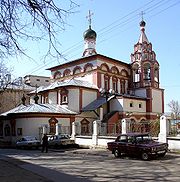
Ivanovsky Convent
Ivanovsky Convent is a large stauropegic Russian Orthodox convent in downtown Moscow, inside the Boulevard Ring, to the west of Kitai-gorod, in the district formerly known as Kulishki. It is the main shrine of St. John the Baptist in the Russian capital.The monastery was first documented in 1604...
(4, Zabelina Street) remains unknown; it was used as a high security prison for state prisoners like Maria Shuiskaya, wife of deposed Vasili IV of Russia
Vasili IV of Russia
Vasili IV of Russia was Tsar of Russia between 1606 and 1610 after the murder of False Dmitriy I. His reign fell during the Time of Troubles....
, and Darya Saltykova. Present-day cathedral and towers were built by Mikhail Bykovsky in 1861. Nearby Moscow Choral Synagogue (10, Bolshoy Spasoglinischevsky Lane) was completed in 1906.
Armyansky Lane, in the beginning of Pokrovka Street, has been a hub of Moscow's Armenian
Armenians
Armenian people or Armenians are a nation and ethnic group native to the Armenian Highland.The largest concentration is in Armenia having a nearly-homogeneous population with 97.9% or 3,145,354 being ethnic Armenian....
community since late 18th century, starting as the base of Lazarev
Lazarev
Lazarev , or Lazareva is a Slavic last name and may refer to:-People:*Alexander Nikolayevich Lazarev , Russian conductor* Alexander Sergeevich Lazarev , Russian actor...
merchant family of Armenian descent. Lazarev's Institute of Oriental Languages, founded in 1814, has been an official school for Russian diplomats since 1827; today, its neoclassical building houses the embassy of Armenia
Armenia
Armenia , officially the Republic of Armenia , is a landlocked mountainous country in the Caucasus region of Eurasia...
. Nearby Maly Zlatoustinsky Lane was home to Matvey Kazakov
Matvey Kazakov
Matvey Fyodorovich Kazakov was a Russian Neoclassical architect. Kazakov was one of the most influential Muscovite architects during the reign of Catherine II, completing numerous private residences, two royal palaces, two hospitals, Moscow University, and the Kremlin Senate...
's home and workshop (recently demolished).
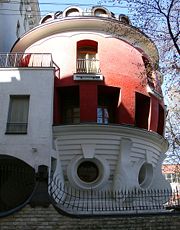
Khitrovka
Khitrov marketplace , also known as Khitrovka , was a square in the centre of Moscow from 1820 to 1930. This square was located in place of today’s house №11a in Podkolokolny sidestreet. In the second half of the 19th century Khitrovka became a bawdy place of Moscow, a den for thousands of...
- former "bottom of Moscow" between present-day Pokrovsky Boulevard
Pokrovsky Boulevard
Pokrovsky Boulevard is a major boulevard in the central part of Moscow running from Clean Ponds to Vorontsovo Pole Street, including Yauzsky Boulevard....
, Khokhlovsky Lane and Solyanka Street. Khitrov market, set up in 1820s, became a flophouse
Flophouse
A flophouse , doss-house or dosshouse is a place that offers very cheap lodging, generally by providing only minimal services.-Characteristics:...
district in 1860s and a gang land by 1880s, concentrating thousands of former peasants who failed to adjust to city life. Many original buildings of Khitrovka still stand, although the market and the infamous flophouses were replaced college buildings.
In Soviet period, reconstruction of Basmanny District lagged behind that of western districts. In 1930s, Basmanny lost landmarks like Red Gates and Assumption Church in Pokrovka
Naryshkin Baroque
Naryshkin Baroque, also called Moscow Baroque, or Muscovite Baroque, is the name given to a particular style of Baroque architecture and decoration which was fashionable in Moscow from the turn of the 17th into the early 18th centuries.-Style:...
, but overall city fabric remains unchanged, with an irregular maze of lanes and two-story historical buildings. Apartment buildings on the boulevards, instead of demolition, were expanded in depth and height, retaining original finishes.
Basmannaya Sloboda

Sloboda
Sloboda was a kind of settlement in the history of Russia, Belarus and Ukraine. The name is derived from the early Slavic word for "freedom" and may be vaguely translated as "free settlement"....
was too large for bakers alone. This sloboda occupied the beginning of Staraya Basmannaya Street, while the present-day Novaya Basmannaya Street was known as Kapitanskaya (Captain's) sloboda and housed the officers of "European" troops established by Peter I. Church of St. Peter and Paul in this area was built in 1705–1723 to the draft made by Peter himself, in early Baroque
Baroque
The Baroque is a period and the style that used exaggerated motion and clear, easily interpreted detail to produce drama, tension, exuberance, and grandeur in sculpture, painting, literature, dance, and music...
style (the church technically stands in Krasnoselsky District
Krasnoselsky District
Krasnoselsky District is the name of several administrative and municipal districts in Russia.*Krasnoselsky District, Moscow, a district in Central Administrative Okrug of Moscow...
).
Previous rulers travelled to their country estates via Staraya Basmannaya, however, Peter changed this habit in favor of Novaya Basmannaya, adding to the popularity of this street among the nobles. In the middle of 18th century, when nobility was relieved from compulsory service, both streets were redeveloped with suburban estates of families like Rumyantsev
Rumyantsev
The Rumyantsev family were Russian counts prominent in Russian imperial politics in the 18th and early 19th centuries. The family claimed descent from the boyar Rumyanets who broke his oath of allegiance and surrendered Nizhny Novgorod to Vasily I of Moscow in 1391.The first Rumyantsev to gain...
s and Golitsyns. In 1750s, they commissioned Dmitry Ukhtomsky
Dmitry Ukhtomsky
Prince Dmitry Vasilyevich Ukhtomsky, Дмитрий Васильевич Ухтомский was the chief architect of Moscow, Russia during the reign of Empress Elizabeth.-Biography:...
to build the extant church of Martyr Nikita, the largest example of Baroque
Baroque
The Baroque is a period and the style that used exaggerated motion and clear, easily interpreted detail to produce drama, tension, exuberance, and grandeur in sculpture, painting, literature, dance, and music...
architecture in Moscow.
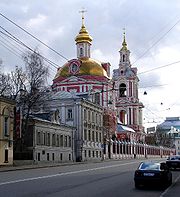
Vasily Pushkin
Vasiliy Lvovich Pushkin was a minor Russian poet best known as an uncle of the much more famous Alexander Pushkin....
, uncle of Alexander Pushkin, owned such single-story wooden house at 36, Staraya Basmannaya. The poet himself was born in nearby Malaya Pochtovaya Street (exact location of his birthplace remains disputed and was previously stated as either 40 or 57, Baumanskaya Street).
In 1900s-1910s, both streets acquired 5-7 storey apartment buildings in Art Nouveau
Art Nouveau
Art Nouveau is an international philosophy and style of art, architecture and applied art—especially the decorative arts—that were most popular during 1890–1910. The name "Art Nouveau" is French for "new art"...
and Neoclassical Revival styles. Most notable is 15, Staraya Basmannaya by Vasily Schaub with Fyodor Schechtel
Fyodor Schechtel
Fyodor Osipovich Schechtel was a Russian architect, graphic artist and stage designer, the most influential and prolific master of Russian Art Nouveau and late Russian Revival....
artwork and clear Vienna Secession
Vienna Secession
The Vienna Secession was formed in 1897 by a group of Austrian artists who had resigned from the Association of Austrian Artists, housed in the Vienna Künstlerhaus. This movement included painters, sculptors, and architects...
features, built to order of Moscow's only Persian
Persian people
The Persian people are part of the Iranian peoples who speak the modern Persian language and closely akin Iranian dialects and languages. The origin of the ethnic Iranian/Persian peoples are traced to the Ancient Iranian peoples, who were part of the ancient Indo-Iranians and themselves part of...
property developer (Naschokina, p.432). In Soviet period, most of this architecture survived, excluding the blocks near the Garden Ring, which now house Ivan Fomin
Ivan Fomin
Ivan Aleksandrovich Fomin was a Russian architect and educator. He began his career in 1899 in Moscow, working in the Art Nouveau style. After relocating to Saint Petersburg in 1905, he became an established master of the Neoclassical Revival movement...
's constructivist
Constructivist architecture
Constructivist architecture was a form of modern architecture that flourished in the Soviet Union in the 1920s and early 1930s. It combined advanced technology and engineering with an avowedly Communist social purpose. Although it was divided into several competing factions, the movement produced...
"Tank Engine Building" (Ministry of Railways).
German Quarter
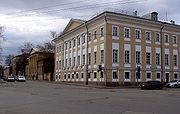
German Quarter
German Quarter, also known as the Kukuy Quarter was a neighborhood in the northeast of Moscow, located on the right bank of the Yauza River east of Kukuy Creek , within present-day Basmanny District of Moscow....
emerged between present-day Baumanskaya Street and Lefortovskaya Square in late 16th century and was repopulated with Europeans of all nations after 1652, becoming then known as New German sloboda
Sloboda
Sloboda was a kind of settlement in the history of Russia, Belarus and Ukraine. The name is derived from the early Slavic word for "freedom" and may be vaguely translated as "free settlement"....
. By 1672, it had three Lutheran
Lutheranism
Lutheranism is a major branch of Western Christianity that identifies with the theology of Martin Luther, a German reformer. Luther's efforts to reform the theology and practice of the church launched the Protestant Reformation...
and two Calvinist
Calvinism
Calvinism is a Protestant theological system and an approach to the Christian life...
churches (Sytin, p.310) and numerous factories.
Tsar Peter, who grew up in nearby sloboda behind Yauza River
Yauza River
This article is about a river in Moscow, a tributary of the Moskva River. There are three other Yauza rivers in Central Russia: tributaries of the Lama, Gzhat and Sestra....
, was a frequent guest in this settlement and built a palace for Franz Lefort
Franz Lefort
Franz Lefort was a Russian military figure of Swiss origin, general admiral , and close associate of Peter the Great....
(which later passed to Alexander Menshikov
Aleksandr Danilovich Menshikov
Aleksandr Danilovich Menshikov was a Russian statesman, whose official titles included Generalissimus, Prince of the Russian Empire and Duke of Izhora , Prince of the Holy Roman Empire, Duke of Cosel. A highly appreciated associate and friend of Tsar Peter the Great, he was the de facto ruler of...
). The palace currently housed military archives. Present-day old hall of Moscow State Technical University, established in 1830, incorporated this palace, as well as former Alexander Bezborodko
Alexander Bezborodko
Prince Alexander Andreyevich Bezborodko was the Grand Chancellor of Russia and chief architect of Catherine the Great's foreign policy after the death of Nikita Panin.-Ukrainian origins:...
palace rebuilt by Domenico Giliardi
Domenico Giliardi
Domenico Gilardi , was a Swiss architect who worked primarily in Moscow, Russia in Neoclassicist style. He was one of key architects charged with rebuilding the city after the Fire of 1812...
.
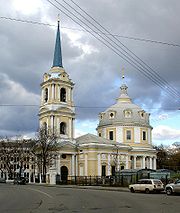
Emancipation reform of 1861
The Emancipation Reform of 1861 in Russia was the first and most important of liberal reforms effected during the reign of Alexander II of Russia. The reform, together with a related reform in 1861, amounted to the liquidation of serf dependence previously suffered by peasants of the Russian Empire...
. Notable additions in the Soviet period were the TsAGI
TsAGI
TsAGI is a transliteration of the Russian abbreviation for Центра́льный аэрогидродинами́ческий институ́т or "Tsentralniy Aerogidrodinamicheskiy Institut", the Central Aerohydrodynamic Institute....
buildings in Radio Street and the numerous expansions of Technical University.
In late 1990s, the area became the site of Lefortovo tunnel
Lefortovo tunnel
Lefortovo tunnel is a road tunnel in the Lefortovo District in Moscow, Russia, opened in 2003. It is a part of the Third Ring Road. At 3.2 km long, it is the third longest in-city tunnel of Europe .The tunnel runs under the Yauza River, and water leaks in at some points...
construction, completing the Third Ring
Third Ring
The Third Ring Road, or The Third Ring, is Moscow's newest beltway, located between the Garden Ring in the city centre and Moscow Ring Road....
freeway. February 23, 2006, a roof of Baumansky market in the center of German Quarter collapsed, killing 56. The land, cleared of rubble, is still vacant, used for storing impounded cars.
External links
- Basman.ru, Official site of district authorities
- Basman495.info, District news
See also
- Basmanny market roof collapseBasmanny market roof collapseBasmanny market's roof had collapsed of February 23, 2006 in Moscow. 66 citizens of Azerbaijan, Russia, Georgia, Tajikistan and Uzbekistan were killed. The architect of the market was Nodar Kancheli.-References:*...
- Izmaylovo DistrictIzmaylovo DistrictIzmaylovo District is a district in Eastern Administrative Okrug of Moscow, Russia. It is a historical part of Moscow, the ancestral land of the Romanov noble family. Population: Area: .-History:...

